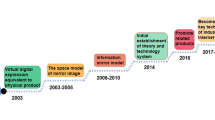Abstract—
The development of information models of physical systems posed the problem of generating a digital twin. A fully-functional digital twin can be created if many of its projections interact simultaneously. The projection interaction problem is due to a set of approaches to decomposing a real-world object and aggregation of an information object. It is proposed to establish relationships between projections by detecting shared data flows using collinear structures.



Similar content being viewed by others
REFERENCES
de Bortoli, M.G.D., The use of an integrated CAE/CAD/CAM system during the compressor design, International Compressor Engineering Conference, 2002.
Gujarathi, G.P. and Yongsheng Ma, Parametric CAD/CAE integration using a common data model, J. Manuf. Syst., 2011, vol. 30, pp. 118–132. https://doi.org/10.1016/j.jmsy.2011.01.002
Qi, Q., Tao, F., Zuo, Y., and Zhao, D., Digital twin service towards smart manufacturing, 51st CIRP Conference on Manufacturing Systems CIRP 72, 2017, pp. 237–242.
Reeves, C., Spotlight on the Digital Twin, ANSYS Advantage, 2017, no. 1, pp. 1–7.
Shvedenko, V.N. and Volkov, A.A., Implementation of parallel structures in object-oriented DBMS, Prom. Avtom. Sist. Upr. kontrollery, 2011, no. 6, pp. 62–64.
Shvedenko, V.N. and Volkov, A.A., A model for the formation of parallel structures in object-oriented DBMS, Program. Prod. Sist., 2011, no. 3, pp. 14–17.
Sokolov, B.V., Zelentsov, V.A., Kulakov, A.Yu., and Pimanov, I.Yu., Models and methods of reconfiguration of complex technical objects under different situation conditions, Trudy mezhdunarodnoi nauchnoi konferentsii Mathematical methods in engineering and technology MMET NW 2018 (Proc. Int. Sci. Conf. Mathematical Methods in Engineering and Technology MMET NW 2018), 2018, pp. 361–363.
Shi, C., Li, Y., Zhang, J., Sun, Y., and Yu, P.S., A survey of heterogeneous information network analysis, IEEE Trans. Knowl. Data Eng., 2017, vol. 29, no. 1, pp. 17–37.
Sokolov, B., Yusupov, R., Okhtilev, M., and Maydanovich, O., Influence analysis of information technologies on progress in control systems for complex objects, New Trends in Information Technologies. Proceedings of International Conference Information-Interaction-Intellect, Sofia, 2010, pp. 78–91.
Wang, Q.G., Zhang, Y., and Chiu, M.S., Decoupling internal model control for multivariable systems with multiple time delays, Chem. Eng. Sci., 2002, vol. 57, no. 1, pp. 115–124.
Mencagli, G. and Vanneschi, M., Towards a systematic approach to the dynamic adaptation of structured parallel computations using model predictive control, Cluster Comput., 2014, vol. 17, no. 4, pp. 1443–1463.
CONFLICT OF INTEREST
The authors declare that they have no conflict of interest.
Author information
Authors and Affiliations
Corresponding authors
Additional information
Translated by O. Pismenov
About this article
Cite this article
Shvedenko, V.N., Volkov, A.A. A Method for Digital Twin Generation Based on the Aggregation of Information Objects. Autom. Doc. Math. Linguist. 53, 122–126 (2019). https://doi.org/10.3103/S0005105519030038
Received:
Published:
Issue Date:
DOI: https://doi.org/10.3103/S0005105519030038




